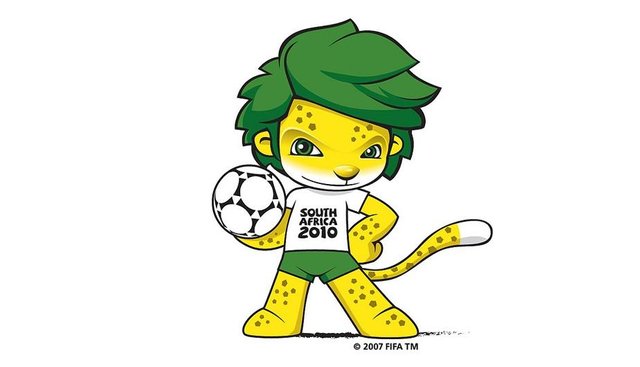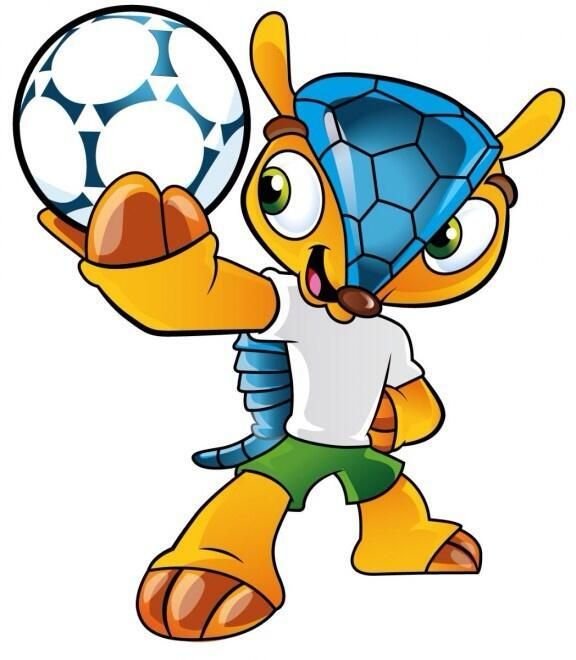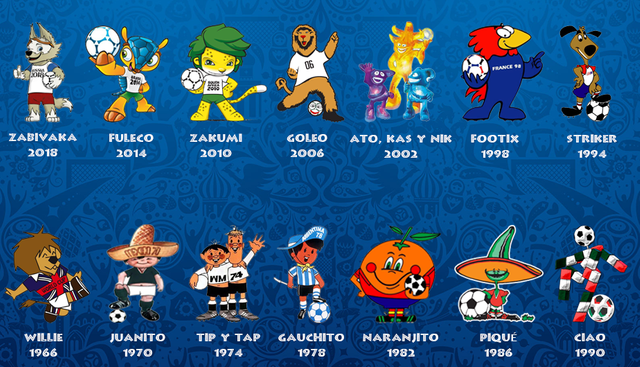The 1966 World Cup in England was the first to officially present a mascot to represent him. From that year, all the World Cups had theirs, and that would serve to promote them and promote the trade of everything related to that global competition.
ZABIVAKA
(Russian: Забивака "Little Scorer") is the official mascot of the 2018 Soccer World Cup to be held in Russia. Represented by an anthropomorphic wolf in a white and blue shirt with the words "RUSSIA 2018", and wearing orange sports glasses. The colors of his uniform (white, blue and red) are those of the Russian team. The student designer of the mascot is Ekaterina Bocharova, and was selected by voting on the Internet.
He is charming, self-confident and sociable, he has always dreamed of being a football star. His favorite pastime is football and he always plays with sportsmanship, valuing his teammates and respecting his opponents; He knows very well what he does. Everyone enjoys their company, is the most fun of the team and makes others laugh. He likes to wear sports glasses when he is in action, because he thinks that they improve his ability in the field and he also likes to pose.
(https://cdn.steemitimages.com/DQmby1iiEKLob7GsMuNDff1BhVnJoofGhQR7t3dn5XwwWdN/descarga%20(1).jpg)!
GOLEO VI
or simply Goleo (October 3, 1985) is the name of the mascot of the 2006 Soccer World Cup, which was held in Germany. Goleo VI is a lion dressed in a white shirt in which the numbers 06 are written, referring to the year 2006 of celebration of the World Cup. Goleo is accompanied by Pille, a talking ball. Goleo was created by the company of Jim Henson with a cost of 250,000 euros.
The name of this mascot has different meanings. In most countries of the world, the term is intimately linked with the word goal (although in German, Tor is said). In addition, it includes references to cries of support such as "Go, Leo, Go" (in English, "Vamos, león, vamos") and the classic Hispanic Olé.
FOOTIX
was the mascot of the Soccer World Cup organized by France in 1998. It represents a rooster, one of the national symbols of the French country, with the words France 98 (France 98) on its chest.
The design of this character emerged after a contest between the most prestigious design agencies in France, winning the design of Fabrice Pialot. Subsequently, a survey of 18,500 French people was conducted to see what the name of the pet would be. The options were Footix, Zimbo, Houpi, Gallik and Raffy, winning with 47% of the votes the first option. These names had been selected according to a series of previous criteria, but, above all, should have an easy pronunciation and not have a negative connotation in any of the world's languages.
mascota98.jpg
ZAKUMI
was the official mascot of the 2010 Soccer World Cup held in South Africa. It is an anthropomorphic African leopard with green hair, designed by Andries Odendaal, a South African designer originally from Cape Town. It was presented on September 22, 2008.
Its name comes from "ZA" (the ISO code for South Africa) and "kumi", which means ten in several African languages. Tim Modise, official spokesman for the World Cup organizing committee, reported that it can also be translated as "come here" in some African languages. Zakumi's birthdate coincides with the International Day of the African Child, known in South Africa as "Youth Day". In 2008 it was reported that, having been created in 1994, "was part of the South African free generation born in democracy", since the year 1994 is considered the birth of democracy in South Africa.
The green and yellow colors resemble those of the South African sports teams, including the national football team. However, and unlike other pets, does not wear the shirt of the national soccer team of that country, but wears a simple white shirt with the inscription "South Africa 2010" ("South Africa 2010", in English).
Zakumi's official motto, "Zakumi play fair", was shown in digital advertising boards during the 2009 FIFA Confederations Cup and the World Cup 2010.2 amused fans during breaks, matches, 3 and official installations of FIFA Fan Fest.4 It is the first character to have two versions of the design, both two-dimensional and three-dimensional. A strange Twitter account is known, which ended on July 21, 2010; However, it was not declared an official account because it did not have its own website

FULECO
was the official mascot of the 2014 FIFA World Cup Brazil. Fuleco is an armadillo of the species Tolypeutes tricinctus (Brazilian three-banded armadillo), according to its scientific name, and its name joins the words Soccer (Ful) and Ecology ( Echo). On November 26, 2012, with a total of 48% of the votes, Fuleco was the chosen name, leaving behind Zuzeco, with 31% of the votes, and Amijubi with 21% of the votes.
Since the custom of assigning a mascot for the World Cup has been established, they have had a significant element; but this one did not become transcendent until 2006, when Goleo VI presented its own album with the World Cup songs. Fuleco is the second mascot, after Zakumi, to have more a song of his own than a record. It is the twelfth mascot in the history of this event; sixth in being an animal since World Cup Willie; the fifth with a song; 4 the fourth of the American continent; the second in South America and the first armadillo in history. It is the second mascot of the world in having two models of drawing: a two-dimensional, used for official products, and another three-dimensional, which is used in the official site, marketing and products of the sponsors; is the second to have a wardrobe consisting of a white shirt and green shorts; besides a name formed by the characteristics of the host country, being its predecessor, Zakumi, who will initiate this new era of pets. It also stands out that it is the first mascot that has official accounts in social networks, such as Facebook and Twitter; where he writes messages in English from England and in Brazilian Portuguese; apart from a dedicated web page. It is known to have been born in the Cerrado Ecoregion, a well-known ecosystem in Brazil.!

